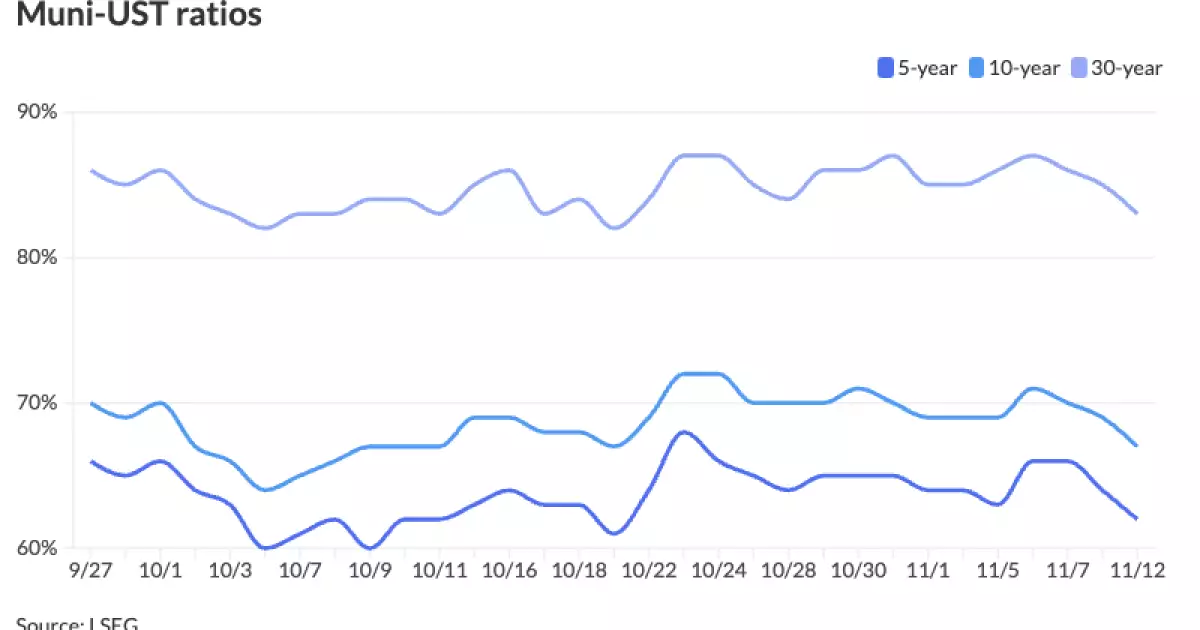The municipal bond market has recently demonstrated a complex interplay of resilience and responsiveness amidst the shifting currents of larger financial instruments like U.S. Treasuries. On a recent trading day, municipal securities exhibited a narrowly mixed performance, seemingly unaffected by the more pronounced losses experienced in the U.S. Treasury market, which saw 10-year yields rise by up to 12 basis points. This article delves into the significant dynamics within the municipal market, highlighting relative value movements, market performance, and prevailing investor sentiments.
On a day marked by volatility, municipals showcased diverse yield adjustments across various curves. Unlike the U.S. Treasury securities that ended deeper in negative territory, municipal curves reflected subtle shifts, with triple-A yields experiencing minimal increases or decreases ranging from one to two basis points. This stability is indicative of the municipals’ unique position in the broader fixed-income landscape; they often appeal to a different segment of investors who may prioritize stability and tax-exempt income over the volatile movements of Treasury yields.
Interestingly, reported yield ratios between municipalities and their Treasury counterparts exhibited minor variations. The two-year municipal to U.S. Treasury ratio stood at 61%, while the 30-year ratio was comparatively higher at 83%. Such ratios can serve as crucial indicators of valuation and investor interest, with higher ratios typically reflecting either heightened demand for tax-exempt returns or a perceived risk premium within longer-duration investments.
Despite the tumultuous environment, there’s encouraging news for municipal securities. Year-to-date performance metrics have shown that municipals are outperforming U.S. Treasuries both monthly and annually. According to recent data, the Bloomberg Municipal Index reported a modest gain of 0.52% in November, coupled with an impressive return of 1.33% for the year thus far. In contrast, the Treasuries recorded lackluster performances, remaining flat in November yet managing a slight gain of 1.37% over the same stretch.
The influence of market dynamics, particularly the Federal Reserve’s monetary policies, cannot be overlooked. Following a notable rate cut of 25 basis points that eased rate volatility, demand for municipal bonds surged, driving yields down significantly. Senior strategists have noted that this “sharp” rally reflects a reinvigorated investor appetite for municipal bonds, suggesting a positive outlook for demand as reinvestment flows continue.
Investor Behavior: Inflows and Demand Trends
As the municipal bond landscape matures, investor behavior has evolved distinctly. Recent weeks witnessed a notable inflow of $1.263 billion into municipal mutual funds, marking the 19th consecutive week of inflows. This trend underscores a growing preference for fixed-income solutions within a context of decreasing yield opportunities elsewhere, particularly in taxable assets.
However, market specialists caution against a potential slowdown in new-money flows as the year wanes. Typically, investors exhibit caution towards purchasing funds late in the year due to the looming possibility of taxable capital gains distributions. This trend underscores a tactical shift, as financial advisors and investors alike navigate complex tax implications in their investment strategies, demonstrating an evolving sophistication in investor behavior amidst fluctuating market conditions.
Supply Dynamics: Navigating Future Offerings
Looking ahead, the supply of municipal bonds presents both challenges and opportunities. The Bond Buyer recorded a sharp decline in visible supply, now pegged at $10.56 billion. This reduction, stemming from the pre-election boom, might restrict immediate opportunities to invest in new issues. Nonetheless, certain prominent deals are poised to enter the market shortly, including substantial offerings related to airport improvements and housing initiatives.
As the calendar year reaches its conclusion, the limited number of trading weeks remaining could further constrict supply, yet also heighten interest in upcoming offerings. The market anticipates significant transactions from various municipal authorities, reflecting essential infrastructure projects and community services in critical markets.
The municipal bond market is navigating a complex landscape characterized by mixed yields and varied investor sentiment, but remains strategically positioned for favorable performance relative to U.S. Treasuries. With resilient inflows, a proactive investment stance from participants, and crucial upcoming supply, there exists a unique opportunity for investors to capitalize on the merits of municipal investments. As strategic decisions unfold in the months ahead, the municipal market’s agility will likely play a vital role in shaping investor outcomes and enhancing portfolio performance.

